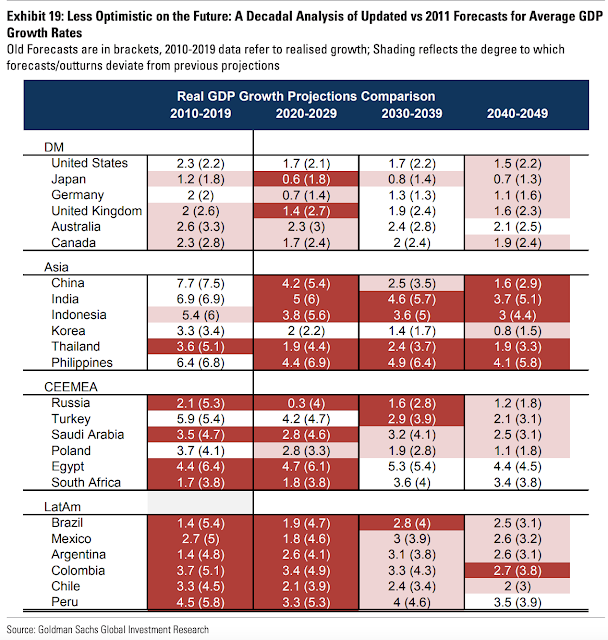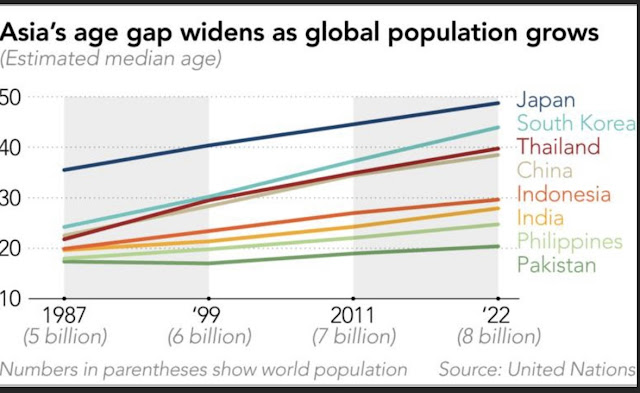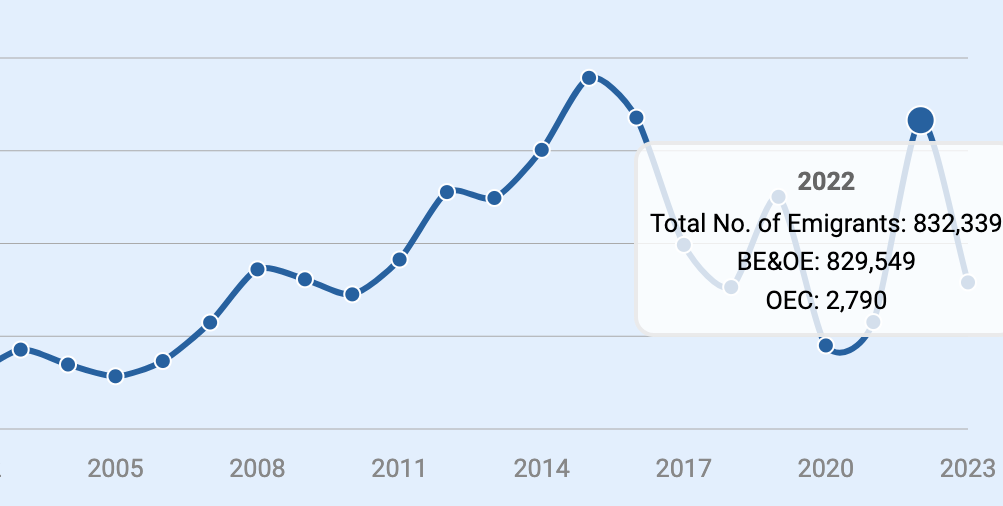
Independence Day: Growing Share of Working Age Population in Pakistan
Dependency ratio, defined as the percentage of children and retirees to the working age population, is rapidly declining in Pakistan ( cur...
Dependency ratio, defined as the percentage of children and retirees to the working age population, is rapidly declining in Pakistan (current dependency ratio is 69.03%) and the rest of the developing nations of Asia and Africa. This demographic shift means that the world's richest and most powerful nations with the largest share of working populations will no longer be in Europe and North America by 2050. Among South Asian nations, Bangladesh has already joined the list of top 10 nations in terms of the largest share of the working age population. India and Pakistan are expected to join it by 2050. Increasingly better educated working age population is expected to significantly enhance their productivity.
The total dependency ratio reported for Pakistan in 2022 is 69.03%, much higher than Bangladesh's 47.09% and India's 47.5%, according to the World Bank. Dependency ratio for China is 44.96% but it is rapidly increasing. China's share of the working age population will no longer be in the top 10 by 2050 due to its aging population, according to the UN projections.
"And then I think what we see (rapidly aging population) in Japan today is only the tip of the iceberg. A lot of East Asia, China, Europe, South Korea will be much older than Japan is today, in just you know, 20 or 30 years. Some countries will have upwards of 40% of their population that are 65 or older in just two or three decades. And meanwhile, on the other end, you have a lot of these other countries that have long been, you know, hindered economically by their age structures. And suddenly a lot of them will start to enjoy the exact same age structures that Europe and East Asia, the U.S., that a lot of those countries have historically enjoyed", Leatherby added.
It is based on this demographic shift that Goldman Sachs analysts Kevin Daly and Tadas Gedminas are projecting Pakistan's economy to grow to become the world's sixth largest by 2075. In a research paper titled "The Path to 2075", the authors forecast Pakistan's GDP to rise to $12.7 trillion with per capita income of $27,100. India’s GDP in 2075 is projected at $52.5 trillion and per capita GDP at $31,300. Bangladesh is projected to be a $6.3 trillion economy with per capita income of $31,000. By 2075, China will be the top global economy, followed by India 2nd, US 3rd, Indonesia 4th, Nigeria 5th and Pakistan 6th. The forecast is based primarily on changes in the size of working age populations over the next 50 years.
Economic Impact of Slower Population Growth:
Daly and Gedminas argue that slowing population growth in the developed world is causing their economic growth to decelerate. At the same time, the economies of the developing countries are driven by their rising populations. Here are four key points made in the report:
1) Slower global potential growth, led by weaker population growth.
2) EM convergence remains intact, led by Asia’s powerhouses. Although real GDP growth has slowed in both developed and emerging economies, in relative terms EM growth continues to outstrip DM growth.
3) A decade of US exceptionalism that is unlikely to be repeated.
4) Less global inequality, more local inequality.
Demographic Dividend:
With rapidly aging populations and declining number of working age people in North America, Europe and East Asia, the demand for workers will increasingly be met by major labor exporting nations like Bangladesh, China, India, Mexico, Pakistan, Russia and Vietnam. Among these nations, Pakistan is the only major labor exporting country where the working age population is still rising faster than the birth rate.
Over a million Pakistani university students are currently enrolled in STEM courses. Over 10 million Pakistanis are currently working/living overseas, according to the Bureau of Emigration. Before the COVID19 pandemic hit in 2020, more than 600,000 Pakistanis left the country to work overseas in 2019. Nearly 700,000 Pakistanis have already migrated in this calendar year as of October, 2022. The average yearly outflow of Pakistani workers to OECD countries (mainly UK and US) and the Middle East was over half a million in the last decade.
World's 7th Largest Consumer Market:
Pakistan's share of the working age population (15-64 years) is growing as the country's birth rate declines, a phenomenon called demographic dividend. With its rising population of this working age group, Pakistan is projected by the World Economic Forum to become the world's 7th largest consumer market by 2030. Nearly 60 million Pakistanis will join the consumer class (consumers spending more than $11 per day) to raise the country's consumer market rank from 15 to 7 by 2030. WEF forecasts the world's top 10 consumer markets of 2030 to be as follows: China, India, the United States, Indonesia, Russia, Brazil, Pakistan, Japan, Egypt and Mexico. Global investors chasing bigger returns will almost certainly shift more of their attention and money to the biggest movers among the top 10 consumer markets, including Pakistan. Already, the year 2021 has been a banner year for investments in Pakistani technology startups.
Record Remittances From Overseas Pakistanis:
Pakistan is already seeing high levels of labor export and record remittances of over $30 billion pouring into the country. Saudi Arabia and the United Arab Emirates(UAE) are the top two sources of remittances but the biggest increase (58%) in remittances is seen this year from Pakistanis in the next two sources: the United Kingdom and the United States.
Remittances from the European Union (EU) to Pakistan soared 49.7% in FY 21 and 28.3% in FY22, according to the State Bank of Pakistan. With $2.5 billion remittances in the first 9 months (July-March) of the current fiscal year, the EU ($2.5 billion) has now surpassed North America ($2.2 billion) to become the third largest source of inflows to Pakistan after the Middle East and the United Kingdom. Remittances from the US have grown 21%, second fastest after the EU (28.3%) in the first 9 months of the current fiscal year.
Pakistan ranks 6th among the top worker remittance recipient countries in the world. India and China rank first and second, followed by Mexico 3rd, the Philippines 4th, Egypt 5th and Pakistan 6th.
About two million Pakistanis are entering the workforce every year. The share of the working age population in Pakistan is increasing while the birth rate is declining. This phenomenon, known as demographic dividend, is coinciding with declines in working age populations in developed countries. It is creating an opportunity for over half a million Pakistani workers to migrate and work overseas, and send home record remittances.
Related Links:
Haq's Musings
South Asia Investor Review
Pakistan is the 7th Largest Source of Migrants in OECD Nations
Pakistani-Americans: Young, Well-educated and Prosperous
Last Decade Saw 16.5 Million Pakistanis Migrate Overseas
Pakistan Remittance Soar 30X Since Year 2000
A Million Pakistani University Students Enrolled in STEM Fields
Two Million Pakistanis Entering Job Market Every Year
Pakistan Projected to Be 7th Largest Consumer Market By 2030
Pakistan Now: Darkest Before Dawn?
Do South Asian Slums Offer Hope?
Pakistan Among World's Largest Food Producing Countries
Riaz Haq's Youtube Channel
PakAlumni: Pakistani Social Network

Independence Day: Growing Share of Working Age Population in Pakistan
Dependency ratio, defined as the percentage of children and retirees to the working age population, is rapidly declining in Pakistan ( cur...
Last edited:





















